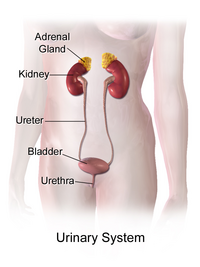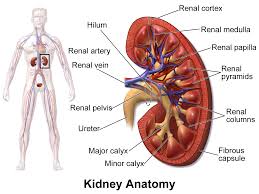Human Excretory system
INTRODUCTION
In human, excretory system consists of a pair of kidneys, one pair of ureters, a urinary bladder and a urethra.
Kidneys
Shape and size- Kidneys are reddish brown, bean- shaped situated between the levels of last thoracic and third lumber vertebrata close to the dorsal inner wall of the abdominal cavity. Each kidney of an adult human measure 10-12 cm in length, 5-7 in width, 2-3 cm in thickness with an avg. weight of 120- 170 g.
Left kidney is little higher than the right one because of more space being occupied by the liver on right side. So, only in human being the right kidney is slightly below the left. But in other mammal, e.g., rabbit, the left kidney is below the right.
Towards the centre of the inner concave surface of the kidney is a notch called hilum through which urete, blood vessels and nerves pass.

Kidney is covered by 3 protective layers are as follows:
- Renal capsule: It is the innermost, tough protective cover made up of white fibrous connective tissue, with few elastic fibres and few muscles.
- Adipose capsule: It is the middle cover linking it with the abdominal wall.
- Renal Fascia: It is the outermost fibrous cover linking it with the abdominal
As the kidneys are fused with the body wall on the dorsal side, peritoneal cover is present only on the ventral side. This arrangement is called retroperitoneal arrangement .
Internal structure:- Inner of the hilum is a broad funnel-shaped space called the renal pelvis with projections called calyces. The outer layer of kidney is a tough capsule. Inside the kidney, there are two zones, an outer cortex and an inner medulla. The medulla is divided into a few conical masses (medullary pyramids) projecting into the calyces (singL calyx). The cortex extends in between the medullary pyramids as renal columns called Columns of Bertini.
Each renal pyramids has a broad base towards the cortical side. Apex is pointed and is called renal papilla. 1-3 renal papillae projected into a cavity called minor calyx, which join up and form major calyces. Interstitial fluid of medulla region has a higher osmotic concentration equal to some 1200 mOsm/L, due to higher quantity of two solutes, NaCl and urea. Cortical region close to medulla is called juxtamedullary area. The major calyces open into a broad funnel-shaped structure called renal pelvis placed inner to hilum. It is lined by transitional epithelium. It leads into ureter.

Ureters:- they in pair of fine whitish distensible muscular tubes of 25-30 cm length, about 3 mm in diameter. Ureters develop from hilum part of kidneys. Descend along the abdominal wall, bend obliquely inwards and upwards to open in to urinary bladder in the region of trigion by oblique slits, one on each side. Wall of ureter has 3 coats- external adeventitia, middle muscular and inner mucosa, Muscular coat has three layers of smooth muscle fibres- outer longitudinal, middle circular and inner longitudinal.
Ureters are always undergoing peristalsis which helps in passing urine from kidney to urinary bladder.
Urinary Bladder:- it is amedian pyriform sac which varies in shape; size and position according to the amount of urine contained in it. The fully distended bladder becomes ovoid in outline. Bladder has three parts- apex, funds or body and neck. Body has a triangular area called trigone It has openings of ureters and an internal urethral orifice. Neckregion possesses two sphincters, involuntary internal sphincter and voluntary external sphincter. Neck leads into urethra.
Wall of urinary bladder consists of three coats- outer adventitia, middle muscular and inner mucosa. The muscle present in the middle muscular coat is also called detrusor muscle because it takes part in detrusion or pushing down of urine. Muscular coat has involuntary circular muscle in the middle and involuntary longitudinal muscles on its either side. Mucosa has loose connective tissue towards the sideof muscular layer and transitional
epithelium or urothelium towards lumen. Adventitia is formed of soft connective tissue.
During the micturition, both the sphincters undergo relaxation. Cerebral cortex direct the sphincter to relax and person undergoes urination. Wall of urinary bladder is innervated by both by both sympathetic and parasymoathetic nervous system.
Urethra:- It is present only in mammals. It starts from the neck of the urinary bladder and opens outside the body. In female, it is short (2-4 cm), straight and concerned with the release of urine through an aperture called urethral orifice or urinary aperture present in the vulva in front of the vaginal aperture. However, in males, it is quite long (20 cm), passes through the prostate gland, cowper’s glands and penis. It is concerned with the release of urine as well as semen (sperms+glandular secretion) through an aperture called urinogenital aperture at the tip of the penis.
ROLE OF OTHER ORGANS IN EXCRETION
Other than kidneys,lungs, liver, and skin also help in the elimination of excretory wastes.
Lungs
Our lungs remove large amounts of CO2 (approximately 200ml/min) and also significant quantities of water every day in normal resting condition. Water loss via lungs is small in hot humid climate and large in cold dry climates.
Liver
Liver is the largest gland of our body. It is the main site for elimination of cholesterol, bile pigments (bilirubin and biliverdin), degraded steroid hormones, some vitamins and many drugs. Liver secretes these substances in the bile. Bile, in turn, carries these materials to the intestine, which are ultimately eliminated with faeces.
Skin
The sweat and sebaceous glands in the skin can eliminate certain substances through their secretions, i.e sweat and sebum respectively. Sweat produced by sweat glands is a watery fluid containing NaCl, small amounts of urea, amino acids and glucose etc. Though the primary function of sweat is 5to facilate a cooling effect on the body surface, it also helps in the removal of some of the wastes mentioned above.
Sebaceous glands eliminate certain substances like sterols, hydrocarbons and waxes through sebum. Sebum is a waxy protective secretion which provide a protective oily covering for the skin.
funfact:-
- The average person produces about 1 to 2 liters of urine per day.
- Urine is around 95% water, but it also contains urea, salts, and various toxins.
- Kidneys filter about 180 liters of blood every day to produce urine.
- Kidneys play a crucial role in regulating blood pressure by controlling the volume of fluids in the body.
- Sweat glands, part of the excretory system, help regulate body temperature by releasing sweat.
- The liver is another important organ in the excretory system; it breaks down toxins and produces bile, which is then excreted as waste.
- The process of excreting solid waste through the rectum and anus is known as defecation.
- The bladder can hold up to about 400-600 milliliters of urine before signaling the need to empty it.
- The color of urine can vary based on factors like hydration level, diet, and medications. For example, eating beets can turn urine pink or red.
- The kidneys are responsible for maintaining the body’s acid-base balance by excreting excess acids or bases in the urine.